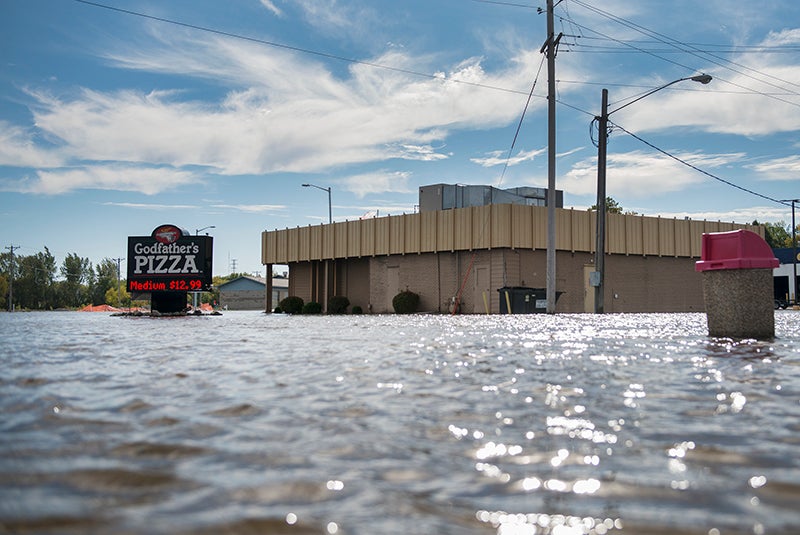‘It’s time to get this done’
Published 8:20 pm Tuesday, October 22, 2019

- The area surrounding Godfather’s Pizza, 509 E. Main St. in Albert Lea, is pictured during September 2016 flooding. East Main Street flood mitigation is one of the projects the city of Albert Lea is making a bonding request for. - Colleen Harrison/Albert Lea Tribune
House committee tours areas in need of state funding
The city of Albert Lea and the Shell Rock River Watershed District had the chance Monday to show the Minnesota House Capital Investment Committee where it would put the combined $32.75 million in bonding funds the entities are asking be included in the 2020 bonding bill.
The Capital Investment Committee has been taking tours across the state every other weekend to hear bonding requests on location, and Albert Lea was included in this week’s regional tour.
The city requested approximately 3/4 of that money in three separate projects: $3.5 million for flood mitigation on East Main Street, $1.75 million to construct a bridge and some remaining path that would connect the Blazing Star Trail between Albert Lea and Hayward, and $20 million for further planning and development of Blazing Star Landing.
City councilors prioritized the requests in that order for the committee at a June City Council meeting.
The $3.5 million would allow the city to either install pumps to displace water back into Fountain Lake after flooding or to raise East Main Street, as each would cost near that, Albert Lea City Manager David Todd said. Should bonding money be granted to the project, he expects the choice on which to do will be left up to the city, he said. However, the road is owned by the Minnesota Department of Transportation, so if MNDOT supplies its own funds for flood mitigation — separate from bonding dollars — he expects the state to raise the road.
“The city views that as an issue that affects commerce and the free flow of traffic,” Todd said. “Obviously both are important.”
There is already approximately $1 million in MNDOT grant funding secured to work on the Blazing Star Trail and bridge, but more funds would be needed to supplement that to complete the projects, Hayward Mayor Mike Hansen said. He said without more bonding funds, there is the potential to lose the already-secured funding because the project could not be finished.
“It’s time to get this done,” District 27A Rep. Peggy Bennett said. Bennett is on the House Capital Investment Committee and attended the tour. She noted the bathrooms and benches put in by the city of Hayward to support the trail, which currently do not have the expected traffic.
“I think we should get this trail finished before those bathrooms crumble back into the earth,” Bennett said.
Bennett said it was made clear that Blazing Star Landing was not the city’s number one priority, and that no state money — if granted — would be used until it had private development.
Todd said requests are typically not funded right off the bat, but that making the requests keeps those projects on the committee’s radar for as long as possible.
He said he knows the bonding committee typically views shovel-ready projects, projects that make a regional impact and projects that are important to the health, safety and wellness of a region favorably.
“Hopefully our requests fall somewhere within that spectrum,” he said.
He said the city was fortunate to host the tour.
“It’s nice when you can make a request and then have them sit right in front of you, know your request and see it and touch it and view it in real time,” he said.
Request from the Watershed District
For the Shell Rock River Watershed District, completing the third phase of dredging is “totally contingent” on bonding, Watershed District Administrator Andy Henschel said. This final phase would be approximately 1/3 of the entirety of Fountain Lake (which includes the main bay, Edgewater Bay and Danes Bay).
The Watershed District has requested $7.5 million, which would allow it to increase the volume of sediment dredged from Fountain Lake to 1.7 million cubic yards. The first two phases will remove about 1.2 million cubic yards, which was still 200,000 more than the original amount expected to be removed.
Henschel said the cost per cubic yard of dredging was not in hand at the time of the original bonding request for dredging, which was also for $7.5 million. It was higher than expected.
Additionally, modeling showed that removing that additional sediment volume would provide the best outcome for reducing phosphorus in the lake, Henschel said.
Should it not receive bonding funds at this time, it would mean Plan B for the Watershed District.
“We don’t know what it is yet,” Henschel said.
But waiting to save up sales tax dollars means costs could go up.
“It’s the district’s feeling that this is the cheapest time to do it,” Henschel said. “It’s only gonna get more expensive.”
Bennett said the committee was also happy to hear about upstream work the Watershed District has done to prevent further sediment coming into Fountain Lake.
These projects include stream bank and stream bed restoration along 2.2 miles of Wedge Creek, wetland restorations upstream and working with farming communities on best management practices.
The probability is that some of the requests will not be approved, Bennett said. There are typically three to four times as many project requests throughout the state than can be granted, she said, and one, realistically, would be what to hope for. Still, she said she is willing to advocate for all four of the projects.
“Even to get one would be really nice,” Bennett said. “To get two would be amazing and probably unlikely, but to get any more than that, you know, that wouldn’t be fair, when you think about it.”





